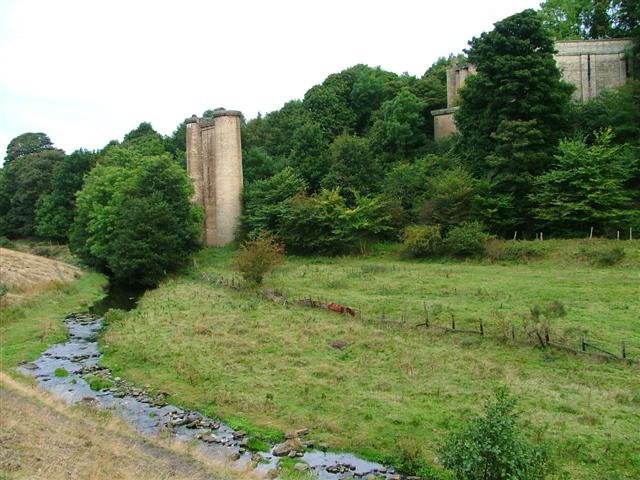Gaunless Viaduct on:
[Wikipedia]
[Google]
[Amazon]
 Gaunless Viaduct, also known as the Lands Viaduct, was a
Gaunless Viaduct, also known as the Lands Viaduct, was a

 Gaunless Viaduct, also known as the Lands Viaduct, was a
Gaunless Viaduct, also known as the Lands Viaduct, was a railway viaduct
A viaduct is a specific type of bridge that consists of a series of arches, piers or columns supporting a long elevated railway or road. Typically a viaduct connects two points of roughly equal elevation, allowing direct overpass across a wide ...
in County Durham
County Durham ( ), officially simply Durham,UK General Acts 1997 c. 23Lieutenancies Act 1997 Schedule 1(3). From legislation.gov.uk, retrieved 6 April 2022. is a ceremonial county in North East England.North East Assembly â€About North East E ...
. It was designed by Thomas Bouch
Sir Thomas Bouch (; 25 February 1822 – 30 October 1880) was a British railway engineer. He was born in Thursby, near Carlisle, Cumberland, and lived in Edinburgh. As manager of the Edinburgh and Northern Railway he introduced the first roll-o ...
to carry the South Durham and Lancashire Union Railway
The South Durham & Lancashire Union Railway (SD&LUR) built a railway line linking the Stockton & Darlington Railway near Bishop Auckland with the Lancaster and Carlisle Railway (the West Coast Main Line) at Tebay, via Barnard Castle, Stainmore ...
between Bishop Auckland
Bishop Auckland () is a market town and civil parish at the confluence of the River Wear and the River Gaunless in County Durham, northern England. It is northwest of Darlington and southwest of Durham.
Much of the town's early history surro ...
and Barnard Castle
Barnard Castle (, ) is a market town on the north bank of the River Tees, in County Durham, Northern England. The town is named after and built around a medieval castle ruin. The town's Bowes Museum's has an 18th-century Silver Swan automato ...
over the River Gaunless
The Gaunless is a tributary river of the Wear in County Durham, England. Its name is old norse, meaning useless.A Potted History of West Auckland - Martin Connolly The Gaunless Viaduct, built in 1825, was the tallest viaduct on the South Dur ...
at Lands
Land is the solid surface of the Earth that is not covered by water.
Land, lands, The Land, or the Lands may also refer to:
Entertainment and media Film
* ''Land'' (1987 film), a British television film by Barry Collins
* ''Land'' (2018 film), ...
, also crossing the Haggerleases branch of the railway to Butterknowle
Butterknowle is a village in Teesdale, County Durham, England. Butterknowle is situated between the market towns of Bishop Auckland (9 miles to the east) and Barnard Castle (6 miles to the south-west). It has an attractive rural setting within t ...
.
Bouch designed the viaduct in 1862 and it was built as four lattice truss
A lattice bridge is a form of truss bridge that uses many small, closely spaced diagonal elements forming a lattice. The lattice Truss Bridge was patented in 1820 by architect Ithiel Town.
Originally a design to allow a substantial bridge to be ma ...
spans supported on diagonally staggered, paired circular brick piers. It opened on 1 August 1863, at a cost of £15,422. It was high with a total span of .
The viaduct was built for double track widths, although only a single line was laid at first. In 1899 work began to lay this second line, but it was found that the ironwork of the trusses was so badly decayed that they needed to be replaced. This work took until at least 1903. Several photographs exist showing the bridge at this time, still operating but with the spans supported by substantial timber shoring Shoring is the process of temporarily supporting a building, vessel, structure, or trench with shores (props) when in danger of collapse or during repairs or alterations. ''Shoring'' comes from ''shore'', a timber or metal prop. Shoring may be verti ...
beneath them.
Demolition

British Railways
British Railways (BR), which from 1965 traded as British Rail, was a state-owned company that operated most of the overground rail transport in Great Britain from 1948 to 1997. It was formed from the nationalisation of the Big Four British rai ...
closed both railways as part of the general decline in local railways of the 1950s and the viaduct was demolished a little over a hundred years after its opening. These closures pre-dated the Beeching Axe
The Beeching cuts (also Beeching Axe) was a plan to increase the efficiency of the nationalised railway system in Great Britain. The plan was outlined in two reports: ''The Reshaping of British Railways'' (1963) and ''The Development of the ...
.
The coal workings of Cockfield Fell on the Butterknowle
Butterknowle is a village in Teesdale, County Durham, England. Butterknowle is situated between the market towns of Bishop Auckland (9 miles to the east) and Barnard Castle (6 miles to the south-west). It has an attractive rural setting within t ...
branch beneath (the Haggerleases branch had been known by this name since 1899) became exhausted. Low Butterknowle pit closed in 1956, Gordon House Colliery in 1961 and Cockfield Drift in 1962. The branch railway closed shortly after, on 30 September 1963.
After gradual closure of the intervening stations in the late 1950s, both passenger and goods services between Bishop Auckland and Barnard Castle, across the viaduct, were withdrawn in June 1962. Two years after closure, the truss girders were removed for scrap. In 1966, two of the brick piers were toppled by explosives, but left on site.
References
Railway viaducts in County Durham Demolished bridges in England Lattice truss bridges South Durham and Lancashire Union Railway Thomas Bouch River Gaunless Buildings and structures demolished in 1964 {{UK-bridge-struct-stub